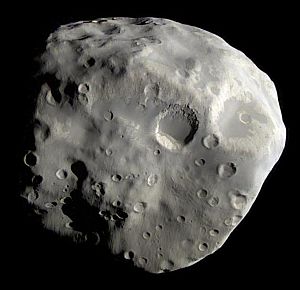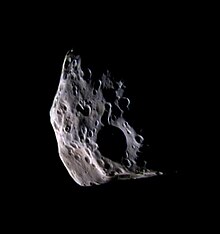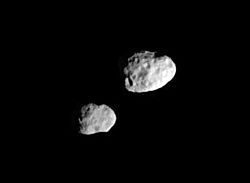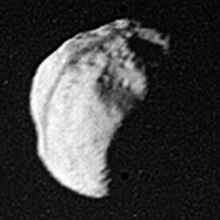Epimetheus (moon)
 As imaged by Cassini on December 3, 2007 | |
| Discovery | |
|---|---|
| Discovered by | Richard Walker |
| Discovery date | December 18, 1966 |
| Orbital characteristics[1] | |
| Epoch 31 December 2003 (JD 2453005.5) | |
| 151 410 ± 10 km | |
| Eccentricity | 0.0098 |
| 0.694 333 517 d | |
| Inclination | 0.351 ± 0.004° to Saturn's equator |
| Satellite of | Saturn |
| Physical characteristics | |
| Dimensions | 135 × 108 × 105 km[2] |
| 56.7 ± 3.1 km[2] | |
| ~40 000 km² | |
| Volume | ~760 000 km³ |
| Mass | 5.304 ± 0.013 ×1017 kg[1] |
Mean density | 0.69 ± 0.11 g/cm³ |
| ~0.0078 m/s2 | |
| ~0.032 km/s | |
| synchronous | |
| zero | |
| Albedo | 0.73 ± 0.03 (geometric)[3] |
| Temperature | ~78 K |
Epimetheus (Template:Pron-en, /ˌɛpɨˈmiːθjuːs/,[4] or as Greek Επιμηθεύς) is an inner satellite of Saturn. It is also known as Saturn XI. It is named after the mythological Epimetheus, brother of Prometheus.
Discovery

Epimetheus occupies essentially the same orbit as the moon Janus. Astronomers assumed that there was only one body in that orbit, and accordingly had difficulty determining their orbital characteristics. Observations were photographic and spaced widely apart in time, so that while the presence of two objects was not obvious, the observations were difficult to reconcile with a reasonable orbit.
Audouin Dollfus observed a moon on December 15, 1966,[5] which he proposed to be named "Janus".[6] On December 18, Richard Walker made a similar observation which is now credited as the discovery of Epimetheus.[7] However, at the time, it was believed that there was only one moon, unofficially known as "Janus", in the given orbit.
Twelve years later, in October 1978, Stephen M. Larson and John W. Fountain realised that the 1966 observations were best explained by two distinct objects (Janus and Epimetheus) sharing very similar orbits.[8] This was confirmed in 1980 by Voyager 1[citation needed], and so Larson and Fountain officially share the discovery of Epimetheus with Walker.
Epimetheus received its name in 1983.[9] The name Janus was approved by the IAU at the same time, although the name had been used informally since Dollfus proposed it shortly after the 1966 discovery.
Orbital relationship between Epimetheus and Janus


Epimetheus and Janus are co-orbital: Janus's mean orbital radius from Saturn is currently only 50 km less than that of Epimetheus, a distance smaller than either moon's diameter. In accordance with Kepler's laws of planetary motion, the closer orbit is completed more quickly, but only by about 30 seconds. Each day the inner moon is an additional ¼° farther around Saturn than the outer moon. As the inner moon catches up to the outer moon, their mutual gravitational attraction boosts the inner moon's momentum and saps the outer moon's momentum. With this added momentum, the inner moon's distance from Saturn and orbital period are increased, and the outer moon's are decreased. The timing and magnitude of the momentum exchange is such that the moons "trade" orbits, never approaching closer than about 10,000 km. The exchange takes place about once every four years; the last close approach occurred on January 21, 2006,[10] the next will be in 2010. At that time, Janus's orbital radius will increase by ~20 km, while Epimetheus's decreases by ~80 km; Janus's orbit is less affected because it is 4 times more massive than Epimetheus. As far as it is currently known, this arrangement is unique in the solar system.
The orbital relationship between Janus and Epimetheus can be understood in terms of the circular restricted three-body problem, as a case in which the two moons (the third body being Saturn) are similar in size to each other. Other examples of the three-body problem include the Lagrangian points, Trojan asteroids and Trojan moons, the "horseshoe" orbit of Cruithne with respect to Earth, and potentially dozens of other objects in similar orbits.[11]
Physical characteristics

There are several Epimethean craters larger than 30 km in diameter, as well as both large and small ridges and grooves. The extensive cratering indicates that Epimetheus must be quite old. Janus and Epimetheus may have formed from a disruption of a single parent to form co-orbital satellites, but if this is the case the disruption must have happened early in the history of the satellite system. From its very low density and relatively high albedo, it seems likely that Epimetheus is a very porous icy body. There is a lot of uncertainty in these values, however, and so this remains to be confirmed.
The south pole shows what might be the remains of a large impact crater covering most of this face of the moon, and which could be responsible for the somewhat flattened shape of the southern part of Epimetheus.
There appear to be two terrain types: darker, smoother areas, and brighter, slightly more yellowish, fractured terrain. One interpretation is that the darker material evidently moves down slopes, and probably has a lower ice content than the brighter material, which appears more like "bedrock." Nonetheless, materials in both terrains are likely to be rich in water ice.[12]
Ring
A faint dust ring is present around the region occupied by the orbits of Epimetheus and Janus, as revealed by images taken in forward-scattered light by the Cassini spacecraft in 2006. The ring has a radial extent of about 5000 km.[13] Its source are particles blasted off the moons' surfaces by meteoroid impacts, which then form a diffuse ring around their orbital paths.[14]
See also
References
- ^ a b Spitale, J. N.; et al. (2006). "The orbits of Saturn's small satellites derived from combined historic and Cassini imaging observations". The Astronomical Journal. 132 (2): 692–710. doi:10.1086/505206.
{{cite journal}}: Explicit use of et al. in:|author=(help) - ^ a b Porco, C. C.; et al. (2006). "Physical Characteristics and Possible Accretionary Origins for Saturn's Small Satellites" (PDF). Bulletin of the American Astronomical Society. 37: 768.
{{cite journal}}: Explicit use of et al. in:|author=(help) - ^ Verbiscer, A.; French, R.; Showalter, M.; and Helfenstein, P.; Enceladus: Cosmic Graffiti Artist Caught in the Act, Science, Vol. 315, No. 5813 (February 9, 2007), p. 815 (supporting online material, table S1)
- ^ In US dictionary transcription, Template:USdict.
- ^ IAUC 1987: Probable New Satellite of Saturn January 3, 1967 (discovery)
- ^ IAUC 1995: Saturn X (Janus) February 1, 1967 (naming Janus)
- ^ IAUC 1991: Possible New Satellite of Saturn January 6, 1967
- ^ Fountain, J. W.; and Larson, S. M.; Saturn's ring and nearby faint satellites, Icarus, Vol. 36 (October 1978), pp. 92–106
- ^ Transactions of the International Astronomical Union, Vol. XVIIIA, 1982 (confirms Janus, names Epimetheus, Telesto, Calypso) (mentioned in IAUC 3872: Satellites of Jupiter and Saturn 1983 September 30)
- ^ NASA JPL, Cassini-Huygens Multimedia: The Dancing Moons, May 3, 2006
- ^ Lloyd, R.; More Moons Around Earth? Its Not So Loony, Space.com, October 29, 1999
- ^ Catalog Page for PIA09813
- ^ NASA Planetary Photojournal PIA08328: Moon-Made Rings
- ^ Cassini-Huygens press release NASA Finds Saturn's Moons May Be Creating New Rings, October 11, 2006
External links
- Epimetheus Profile by NASA's Solar System Exploration
- The Planetary Society: Epimetheus
- 'Solar System Dynamics' by Murray and Dermott The standard text on the subject, describes the orbits in detail.
- Quicktime illustration of co-orbital motion from Murray and Dermott [dead link]
- Cassini image of Janus and Epimetheus near the time of their orbital swap.
